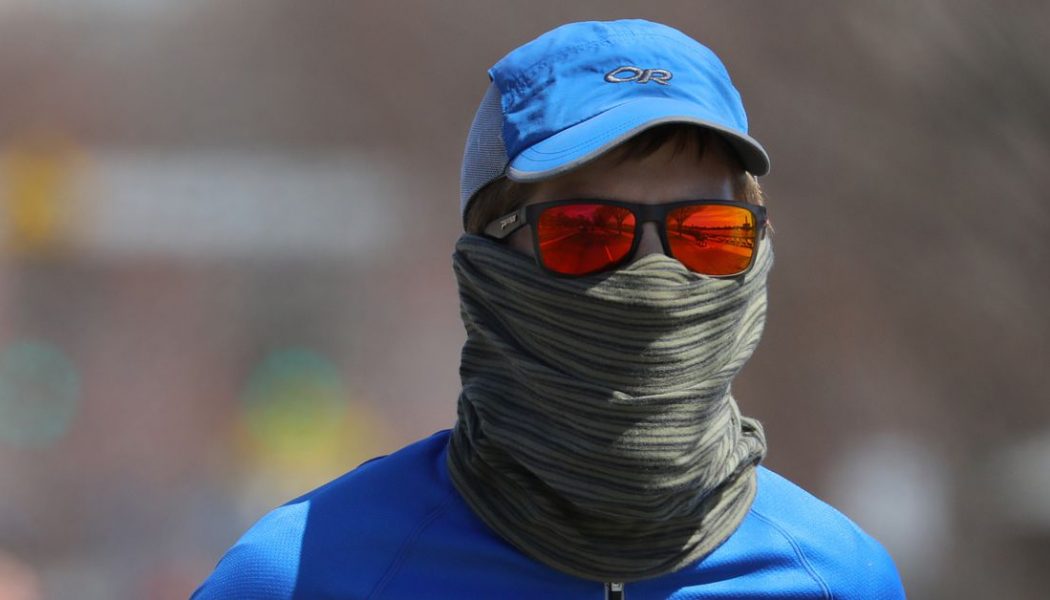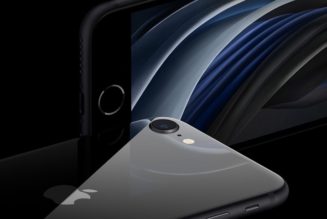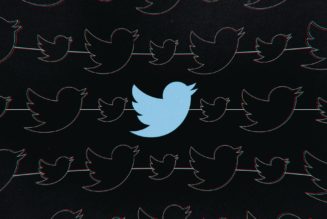
A minor face-covering controversy broke out this week, thanks to a widely-misinterpreted paper involving masks, lasers, and spit.
The study, which came out in Science Advances on August 7, was pretty straightforward. It laid out a method that other scientists could use to test masks in their own labs. Using a dark box, some lasers, a cell phone camera and a relatively simple algorithm they figured out a way to test how effective different kinds of masks were at containing spit.
People spit when they talk. They also spew droplets out of their mouth when they breathe heavily, sneeze, or sing Hamilton tunes. That humid mess can contain viruses, which is one reason that everyone is now encouraged to wear a mask in public — to reduce the chances that you’ll pass the coronavirus that causes COVID-19 on to other people.
Wearing a mask creates a barrier between your germ-filled mouth and the world. (Unless you buy whatever the heck this disaster is.) But with the exception of heavily tested masks, like N95s, researchers don’t have a detailed picture of how well those barriers perform, especially given the huge variety of masks out there.
Which brings us back to the paper. In order to show that their experimental set-up worked, and could work for other researchers, they tested 14 commonly used face-coverings. They “merely demonstrated our method on a variety of commonly available masks and mask alternatives with one speaker, and a subset of these masks were tested with four speakers,” the authors write.
Here’s what they were not doing: they were not running extensive tests on the different mask types. But in their paper, they did see that some masks seemed to do better than others. One of the ones on the lower end of the efficacy pole? Gaiters/buffs/those big cloth necklaces popular with runners. Suddenly The Washington Post was proclaiming that “Wearing a neck gaiter may be worse than no mask at all, researchers find”, much to the dismay of other science journalists.
No, the study ****did not find that****. Not even their own extremely limited data (n=1 person for most tests) show that. And where is the outside scientific comment on this study? WHERE IS IT? Did everyone forget how this works? https://t.co/DyNy7eTupe
— Emily Willingham (@ejwillingham) August 12, 2020
Other articles quickly followed, defending the gaiters and pointing out that we’ll need a lot more reps of these tests to really say, once and for all, how well different masks compare to each other.
Even the authors of the paper agreed.
“What we don’t want people taking away is: ‘This mask will work. This will not.’ It’s not a guide to masks. It is a demonstration of a new, simple methodology for quickly and somewhat crudely visualizing the effect of a mask,” one of the authors told Wired.
The experiment was adapted in part from another demonstration that we covered back in April. That experiment, and others like it that came out at around the same time, also used lasers to highlight people’s spit as they talked. Like the more recent article, their work was also focused on basic scientific set-up, and not on broad conclusions.
“It emphasizes the principle, and then you dig down a layer to get some of the more information,” Alex Huffman, an associate professor who studies aerosols at the University of Denver told Verge reporter Nicole Wetsman back in April. “But it doesn’t solve everything — just like the mask itself.”
What all these scientific papers do is give us the tools that can help us figure out which masks really are effective — information that could help us keep our germs to ourselves in this pandemic, and in the future.
Here’s what else is going on this week.
Research
Long after the fire of a Covid-19 infection, mental and neurological effects can still smolder
Up to a third of COVID-19 patients may experience neuropsychological problems after they recover from the disease. “It’s not only an acute problem. This is going to be a chronic illness,” Wes Ely, a critical care physician at Vanderbilt University Medical Center told STAT. “The problem for these people is not over when they leave the hospital.” (Elizabeth Cooney/STAT)
Vaping linked to higher risk of COVID-19 in teens and young adults, study finds
Teens and young adults who vape were between five and seven times more likely to be diagnosed with COVID-19, according to a new study published in the Journal of Adolescent Health this week. (Justine Calma/The Verge)
Development
Large study suggests convalescent plasma can help treat Covid-19, but experts have doubts
A large, not peer-reviewed study found some hopeful hints that plasma from patients who recovered from COVID-19 could be a decent treatment. But it also left researchers incredibly frustrated. “The lack of high-quality trials in making clinical decisions about how to treat patients with coronavirus infection is a national embarrassment. Here we have another non-randomized study, NIH-funded, and uninterpretable,” Clinical trialist Steven Nissen told STAT. (Damian Garde and Matthew Herper/STAT)
Clinical Trials of Coronavirus Drugs Are Taking Longer Than Expected
Experimental antibody treatments are lingering in clinical trials as researchers run into “testing delays, staffing shortages, space constraints and reluctant patients” according to a report in The New York Times. (Katie Thomas/The New York Times)
Russia rushes registration of unproven coronavirus vaccine
In a fit of nationalism, Russia decided to push its unproven vaccine out into the world, leapfrogging the essential step of phase III clinical trials. Russia is calling it ‘Sputnik V.’ Virologists are calling it “beyond stupid.” (Mary Beth Griggs/The Verge)
Perspectives
I had COVID-19, and these are the things nobody tells you
Sports columnist Bill Plaschke vividly writes about what it was like to catch the virus after months of writing about how the pandemic has upended sports.
It felt like my head was on fire. One night I sweated through five shirts. I shook so much from the chills I thought I chipped a tooth. My chest felt like LeBron James was sitting on it. My fatigue made it feel as if I was dressed in the chains of Jacob Marley’s ghost.
(Bill Plaschke/The Los Angeles Times)
More than numbers
More than 900 healthcare workers have died on the frontline of the COVID-19 pandemic in the US, according to a new report and interactive database built by The Guardian and KHN. The database includes pictures and profiles of 167 medical workers who have died since March.
To the more than 21,240,306 people worldwide who have tested positive, may your road to recovery be smooth.
To the families and friends of the 766,414 people who have died worldwide — 168,458 of those in the US — your loved ones are not forgotten.
Stay safe, everyone.










